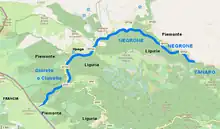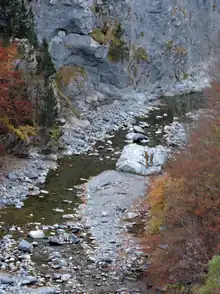Negrone


The Negrone is an 11 kilometres (6.8 mi) long stream principally in Italy that flows through the regions of Piedmont and Liguria. Rising at Cime de Missun in the Ligurian Alps of France, the river, alongside the Tanarello, forms the Tanaro river, itself a tributary of the Po.[1][2] The Negrone is known by several other names in different areas.[3]
Etymology
The origin of Negrone is uncertain; a combination of negro (black) and the suffix -one, it is traced by some to the dark colour of the rocks that emerge in various parts of the creek bed, while others have suggested that the name is derived from the shadyness of the valley traversed by the stream.[2]
Course
The Negrone originates as the Giareto or Ciairello stream on the eastern slope of the Cime de Missun in the Ligurian Alps of France, near the France–Italy border. It then flows a northeasterly course into the municipality of Briga Alta, Piedmont, in Northwest Italy. After briefly flowing into Liguria, after the stream reaches the Strada Provinciale 97 road it proceeds to form the boundary between Piedmont and Liguria. After changing its name to the Corvo just before the stream reaches Upega in Piedmont, it collects the waters of the Nivorina and finally receives the name Negrone, turning eastward. After receiving the waters of the Rio Regioso, the Negrone proceeds to flow a southeasterly course. At Pian Laiardo—between the municipalities of Cosio d'Arroscia and Ormea—it is joined by the Tanarello river, giving rise to the Tanaro.[2][4]
References
- "Linee generali di assetto idrogeologico e quadro degli interventi bacino del Tanaro" [General lines of hydrogeological planning and framework of interventions Tanaro basin] (PDF). Po River District Basin Authority. Retrieved 4 September 2022.
- Badino 2015, p. 56.
- Badino 2015, p. 59.
- "Linguria" (Map). Carta Regionale. 1:25,000 (in Italian). Cartografia. Archived from the original on 29 May 2017. Retrieved 4 September 2022.
Sources
- Badino, Giovanni (December 2015). "La Lunga Via dell'Acqua" [The Long Way of Water] (PDF). Speleologia (in Italian). University of Turin (73): 54–59. ISSN 0394-9761. Retrieved 4 September 2022 – via AperTO.